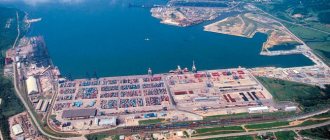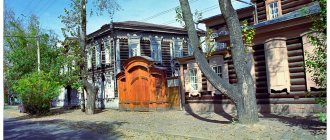City in Irkutsk region, Russia
| Biryusinsk Biryusinsk | |
| Town[1] | |
| View of Biryusinsk | |
| Flag Coat of arms | |
| Location Biryusinsk | |
| Biryusinsk Location Biryusinsk Show map of Russia Biryusinsk Biryusinsk (Irkutsk region) Show map of Irkutsk region | |
| Coordinates: 55°58′N 97°50'E / 55.967°N Latitude 97.833°E / 55.967; 97.833Coordinates: 55°58′N 97°50'E / 55.967°N Latitude 97.833°E / 55.967; 97.833 | |
| A country | Russia |
| Federal subject | Irkutsk region[1] |
| Administrative region | Tayshetsky district[2] |
| Based | 1897 |
| City status from | 1967 |
| Height | 300 m (1000 ft) |
| Population (2010 Census)[3] | |
| • Total | 8,981 |
| • Estimate (2018)[4] | 8,497 (-5.4%) |
| Municipal status | |
| • Municipal district | Taishet municipal district[5] |
| • Urban village | Biryusinskoye village[5] |
| • Capital from | Biryusinskoye village[5] |
| Timezone | UTC + 8 (MSK + 5 [6]) |
| Postal code(s)[7] | 665050–665053 |
| Dial code(s) | +7 39563 |
| OKTMO I WOULD | 25636105001 |
| Web site | www.biryusinsk.ks8.RU |
Biryusinsk
(Russian: Biryusinsk, IPA: [brʲʉˈsinsk]) is a town in Tayshetsky district of Irkutsk region, Russia, located on the right bank of the river. Biryusa River (Angaras basin), 682 km (424 mi) northwest of Irkutsk, then the administrative center of the region. Population: 8,981 (2010 Census);[3]10,004 (2002 Census);[8]12,066 (1989 Census).[9]
Previously he was known as Suetikha
(until 1967).
Story
In 1897, during the construction of the Great Siberian Railway, the Suetikha crossing was founded (the first mention dates back to 1894). The first government barracks-barracks were built near the Biryusa River, in which workers lived. The name of the crossing arose from the Suetikha River flowing nearby. Until 2007, Biryusinsk was administratively subordinate to Taishet.
Some events in the history of Biryusinsk
| Year | Event |
| 1897 | During the construction of the Trans-Siberian Railway, the Suetikha crossing was created |
| 1899 | A small settlement has formed around the crossing |
| 1912 | The first sawmill was launched. The first brick factory was built. |
| 1927 | A new large sawmill is being created |
| 1929 | The second four-frame sawmill went into operation |
| 1932 | A kindergarten and a seven-year school were opened |
| 1933 | Built a club named after. Paris Commune and station building |
| 1934 | The village of Suetikha was transformed into a workers' settlement |
| 1938 | Secondary school opened (No. 6) |
| 1940 | About 1 thousand people are employed in the sawmill production of the village |
| 1943 | A decision was made to develop the hydrolysis industry in the USSR. This decision was formalized by the corresponding decision of the Council of People's Commissars of the USSR dated May 3, 1943. This document became the basis for the design and construction of the Biryusa and Tulun hydrolysis plants. |
| 1946 | The design assignment for the construction of a hydrolysis plant with a capacity of 500 thousand dal was approved. alcohol and 1 thousand tons of yeast in the village of Suetikha. |
| 1947 – 1952 | Construction period of the hydrolysis plant |
| 1952 | The first product was produced - ethyl alcohol. |
| 1952 | There is a library in the village |
| 1953 | The hydrolysis plant has reached its design capacity, producing ethyl alcohol and feed yeast |
| 1955 – 1956 | A new design assignment was developed and approved, which provided for the expansion and modernization of the existing hydrolysis production |
| 1956 | Another secondary school was put into operation (No. 16) |
| 1957 | A new (brick) hospital building was built |
| 1961 | A children's library and another primary school have been opened (No. 10) |
| 1962 | Furfural production began at the hydrolysis plant |
| May 1967 | The village of Suetikha received city status and was renamed Biryusinsk |
| 1971 | The Biryusa cinema with 300 seats was built |
| 1974 | Music school opened |
| 1980 | A building was built for a local history museum and an art school |
| 1986 – 1990 | A sports complex (swimming pool, gym, hockey court) was built at the expense of the hydrolysis plant. |
| 1992 | Hydrolysis plant corporatized |
| 2005 | Hydrolysis plant closed |
| 2008 | The possibility of constructing housing and social and cultural facilities for the Taishet aluminum smelter in Biryusinsk is being considered |
Biryusinsk: history
Fragment from the book by M.A. Vinokurov and A.P. Sukhodolov “Cities of the Irkutsk Region”, 2010
Published on the Baikal region website () with the permission of the authors
Biryusinsk was founded in 1897 during the construction of the Trans-Siberian Railway as a Suetikha crossing*
, around which a small settlement soon formed.
Residents of Suetikhi worked on the railway, were engaged in agricultural work and forestry. The economic development of the region required a large amount of lumber, and logging began in the vicinity of Suetikha (at that time rich in timber), and in 1912 the first sawmill was installed in the village. During the NEP period, new sawmills were organized, soon united into a combine. During these same years, a kindergarten and a seven-year school were opened in the settlement, a club and a railway station building were built, and a suspension bridge was built across the Shipichnaya channel. A medical center and a hospital building with 20 beds were created at the sawmill.
In the mid-1930s. Suetikha received the status of a workers' village. A secondary school was opened here, and students no longer had to walk to Taishet to receive a secondary education.
The key to the fate of the future city was the decision made during the turning point of the Great Patriotic War (spring 1943) to build new hydrolysis plants on the territory of the USSR (including in Eastern Siberia). Their products were in great demand. Military hospitals, defense enterprises, aviation and water transport, and other industries and areas of the economy experienced a shortage of ethyl alcohol. It was also extremely important that the hydrolysis production of alcohol did not require food raw materials, which were in acute shortage in those years. Moreover, hydrolysis plants themselves supplied the country's livestock complex with feed yeast rich in high-quality protein and essential amino acids (and in besieged Leningrad, hydrolysis products were used as an additive to bread). Another by-product of hydrolysis production, carbon dioxide, used in the food industry, was also in great demand.
The decision to build new hydrolysis plants was formalized by order of the Council of People's Commissars of the USSR on May 3, 1943, and this document became the basis for the design and then construction of a hydrolysis plant in Suetikhe - one of the largest in the east of the country.
The design assignment for its construction was approved by Glavlesospirtprom on January 24, 1944. Initially, its annual capacity was determined at 500 thousand dal of alcohol and 1 thousand tons of yeast. Subsequently (1955-1956), a new design assignment was developed and approved, which provided for the expansion and modernization of the existing production.
Construction began in 1947. For this purpose, a construction and installation department was created in Suetikhe, the brick factory that was operating in those years was expanded, and a power plant was built. In order to reliably provide the future enterprise with raw materials, the capacity of the existing sawmills in the village was increased.
The choice of site for a new plant in the village of Suetikha was determined by the following factors:
— the presence of sawmill waste (a large sawmill was located 500 m from the future plant);
— the presence of large reserves of clean fresh water (the resources of the Biryusa River, which originates in the Eastern Sayan mountains, were used for water supply);
— close location of coal deposits (brown coal from the Irsha-Borodinsky open-pit mine, located approximately 160 km away, was used as fuel);
— high transport accessibility of the territory (the Trans-Siberian Railway passed nearby, the Abakan-Taishet highway was being built);
— availability of free labor resources in the village of Suetikha and nearby villages.
The new plant produced its first products in March 1952 and already in 1953 reached its design capacity, producing ethyl alcohol and feed yeast (the production of furfural was established in 1962). To install equipment and launch production, specialists from the Arkhangelsk hydrolysis plant arrived in the village of Suetikha, many of whom remained to work in the Irkutsk region. Soon the Biryusinsky plant itself became a source of personnel for other enterprises in the hydrolysis and microbiological industries of the region.
To produce alcohol, yeast and furfural, the plant used sawmill and woodworking waste (chips and sawdust), as well as agricultural waste (substandard grain and beet molasses). The raw materials came from logging and agricultural enterprises in the Irkutsk region and the neighboring Krasnoyarsk Territory.
The plant built its own thermal power plant, which installed seven steam boilers with a total thermal capacity of 163 Gcal per hour and two turbogenerators with an electrical power of 7.5 MW. These capacities were enough to provide heat not only to the plant, but also to the housing stock, schools and kindergartens of the village. Subsequently, clean heated water was used to fill the swimming pool. In June 1961, the factory's treatment facilities were put into permanent operation, taking over the treatment of not only industrial, but also village household wastewater.
With the development of the plant, the village grew and improved. Secondary and primary schools, a hospital, a library, and other social and cultural facilities were additionally opened. The population has increased. In 1967, the village received city status and a new name - Biryusinsk (along the Biryusa River).
During this period, the hydrolysis plant, the main city-forming enterprise of Biryusinsk, became the pride of the microbiological industry.
thinking of the USSR. It was one of the largest and technically equipped hydrolysis plants in the country, and was the largest of three similar plants built in other cities of the Irkutsk region. 1,450 people worked there. The plant could annually produce 1,800 thousand dal of ethyl alcohol, 70 thousand tons of carbon dioxide, 13.7 thousand tons of feed yeast and 700 tons of furfural.
Working at the company was very prestigious: high salaries, benefits, honor and respect. Large-scale improvement work was carried out at the plant. Almost its entire territory is paved, the walls in the workshops are covered with tiles, and the floors are laid with marble tiles. A boiler house was built that ran on lignin (a by-product of hydrolysis production), which made it possible to save more than $1 million on fuel annually.
The enterprise was corporatized in 1992. 51% of the shares became federal property, the remaining 49% were distributed equally among the plant employees (each received 11 shares). However, the economic situation in the country did not allow maintaining the hydrolysis production of alcohol. The plant’s debts were constantly growing and at the time of its shutdown reached 480 million rubles. The license to produce alcohol-containing products was revoked. Bankruptcy proceedings began, and in 2005 the plant ceased to exist. With the closure of the plant, the city lost the most important economic basis for its further development.
*
There are two versions of why the crossing was called “Suetikha”: the first - by the name of the Biryusa tributary of the Suetikha River (the hydronym of the river itself is associated with the Turkic “su” - water); the second is due to the fuss that arose during the construction of the railway bridge across Biryusa during the construction of the Trans-Siberian Railway.
Population
The population of Biryusinsk grew steadily until the 1970s, then began to decline due to a slight decrease in the birth rate, mainly due to migration outflow, which increased greatly in the early 2000s after the bankruptcy of the Biryusinsky hydrolysis plant.
Population dynamics
| 1959 | 1970 | 1979 | 1989 | 1996 | 1998 |
| 13 300 | 13 461 | 12 676 | 12 100 | 12 000 | 11 900 |
| 2000 | 2001 | 2005 | 2006 | 2007 | 2008 |
| 11 500 | 11 500 | 9700 | 9600 | 9500 | 9400 |
| 2010 | 2011 | 2012 | 2013 | 2019 | 2020 |
| 8981 | 9000 | 8815 | 8701 | 8430 | 8416 |
As of January 1, 2022, the city ranked 988th out of 1,115 cities in the Russian Federation in terms of population.
Population structure of Biryusinsk in 2009, %
| Population group | Share |
| Preschoolers | 9,0 |
| Pupils | 13,0 |
| Adults | 54,5 |
| Pensioners | 23,5 |
Transport accessibility
The city is located 682 km from Irkutsk, 12 km from Taishet, 400 km from Krasnoyarsk, near the Trans-Siberian Railway, on the banks of the Biryusa River (hence its name), 682 km from the regional center and 12 km from the district.
Distance from Biryusinsk to some cities, km
| City | Distance | |
| by rail | by road | |
| Biryusinsk | — | — |
| Taishet | 13 | 13 |
| Alzamay | 84 | 80 |
| Nizhneudinsk | 176 | 170 |
| Vikhorevka | 282 | 497 |
| Tulun | 293 | 293 |
| Bratsk | 306* | 518 |
| Krasnoyarsk | 405 | 356 |
| Winter | 432 | 426 |
| Cheremkhovo | 552 | 543 |
| Zheleznogorsk-Ilimsky | 568 | 779 |
| Usolye-Sibirskoye | 615 | 616 |
| Angarsk | 643 | 647 |
| Irkutsk | 682 | 691 |
| Ust-Kut | 736** | 887 |
| Ust-Ilimsk | 803 | 778 |
| Slyudyanka | 808 | 803 |
| Ulan-Ude | 1138 | 1141 |
City infrastructure
Streets
Academician Pavlova, Alexander Nevsky, Beregovaya, Berezovaya, Hospital, Bogdan Khmelnitsky, Vodopyanova, Vokzalnaya, Gaidar, Gogol, Gorky, Dachnaya 2nd, Dachnaya 3rd, Druzhby, Zheleznodorozhnaya, Zhelyabova, Zhilgorodok, Zhuravleva, Green 1st, Green 2nd, Green 3rd, Zabobonina, Zavodskaya, Zoya Kosmodemyanskaya, Ivan Beach, Kalinin, Kirov, Komsomolskaya, Red Star, Krupskaya, Kuyshev, Kuprin, Lazo, Lenin, Lermontov, Marat, Matrosov, Mayakovsky, Mira , Mostovaya, Youth 1st, Youth 2nd, Youth 3rd, Embankment, Nagornaya, Nekrasova, Nikitina, Novaya, Oktyabrskaya, Ostrovsky, Paris Commune, Partizanskaya, Pervomaiskaya, Pioneer, Subsidiary Farm. Pobeda, Polevaya, Pushkin, Rechnaya, Sverdlova, Warehouse, Soviet, Sports, Stadium, Construction, Transport, Frunze, Chernyshevsky, Chekhov, Chkalov, Shevchenko, Shkolnaya, Shushkevich, Yubileynaya, Yuzhnaya.
Lanes
Nameless, Vokzalny, Gorky, Lesnoy, Soviet, Transport.
village .
Microdistrict New.
Residential buildings : 4510 km, ECHK-25, MPS.
Economy
The city-forming basis of Biryusinsk was a hydrolysis plant that produced ethyl alcohol, alcohol-containing products, furfural, feed yeast, and carbon dioxide. The enterprise's boiler house provided the city with heat, and the plant's treatment facilities, in addition to production ones, purified household wastewater in Biryusinsk. In 2005, production of the plant was discontinued.
The second most important industry in the city's economy was the railroad. After the closure of the hydrolysis plant, it began to play a decisive role in the economy of Biryusinsk. Currently, this industry is represented by the Biryusinsk railway station and the PMS-67 division of the Eastern Railway, as well as the Tagul distance of the Abakan branch of the Krasnoyarsk Railway.
The third branch of Biryusinsk's specialization was sawmilling. The first sawmill was launched in 1912. In Soviet times, a large sawmill and woodworking plant was created. In the 1990s, all that remained were railway sidings, which began to be used for the shipment of round timber.
Other industries include trade, consumer services, catering, etc. About 20 small enterprises and about a hundred private entrepreneurs are engaged in these types of activities. The importance of these industries in the city’s economy increased significantly after the closure of the hydrolysis plant.
The municipal budget in 2016 amounted to 15 million rubles.
The city of Biryusinsk in the Irkutsk region
General information about the city of Biryusinsk
The city of Biryusinsk is located in the Taishetsky district in the west of the Irkutsk region. The city is located on the right bank of the Biryusa River, after which it got its name. Biryusinsk is considered one of the smallest cities in the region, it is also its westernmost city - it is located near the border of the region with the neighboring Krasnoyarsk Territory. The western position of the city is also reflected in the fact that Krasnoyarsk can be reached faster than Irkutsk - Biryusinsk is located only 400 kilometers from Krasnoyarsk and almost 700 kilometers from Irkutsk. The regional center, the city of Taishet, is only 12 kilometers away; it is often called the satellite city of Taishet. Biryusinsk is connected with other objects of the region by a federal highway and a railway.
History of the city of Biryusinsk
Many cities in Eastern Siberia owe their appearance to the construction of the Trans-Siberian Railway, and Biryusinsk is no exception. The city was founded in 1987 near the Suetikha railway crossing, whose unusual name came from the bustle that accompanied the construction of the highway. The village was formed in just two years, but its economic development took much longer; for a long time the village was completely dependent on neighboring Taishet. The active development of the village began after the opening of the first sawmill in 1912, thanks to which already in the mid-1930s the settlement of Suetikha was awarded the title of a workers' village. The decisive moment in the development of the village was the construction of a new model hydrolysis plant on its territory. The start of construction of the plant in 1947 led not only to the expansion of the settlement’s territory, but also to an increase in its economic potential - all previously existing branches of production were expanded. The development of the plant also affected the development of the village - in 1967 the village received a new name and city status.
Economy of Biryusinsk
Until 2005, the basis of the Biryusinsk economy was the hydrolysis plant, its products included ethyl alcohol, carbon dioxide and other alcohol-containing substances. The boiler house operating at the plant provided heat to almost the entire city, and the plant’s wastewater treatment facilities were used to purify domestic wastewater. After the plant ceased operation, the railway and its maintenance again came to the fore. In Biryusinsk there is a railway station of the same name, as well as a track machine station that carries out scheduled work on the tracks. An important role in the economy of Biryusinsk is played by sawmilling, which began in the city more than a century ago. Today, only round timber is shipped in the city, but the administration’s plans include restoring previous standards for cutting timber. The city also has developed sectors of the economy such as trade, public catering, and consumer services, the importance of which increased sharply after the closure of the plant. They are represented, as a rule, by private enterprises and entrepreneurs.
Sights of Biryusinsk
Biryusinsk is a provincial town; it has no attractions that the whole world knows about. But the charm of the province is not the only thing it can boast of. The only monument in the city is dedicated not to the Soviet leader, as is usually customary in small towns, but to the family - two adult figures symbolize the mother and father, a child sleeps in the latter’s arms. In Biryusinsk there are monuments of Russian Orthodox architecture - the Church of St. Innocent, Bishop of Irkutsk and the Church of the Resurrection of Christ with a bell tower. You can learn in detail about the history of their construction, as well as the general history of the city, in the local Museum of Local Lore, built exclusively with donations from townspeople.
Social sphere
The city has several schools (three for secondary education, one for primary education, music and art) and four municipal pre-school educational institutions. There is a House of Children's Creativity, where there are 12 creative associations in various areas (art, local history, etc.) The Children's Art School of Biryusinsk (MOU DOD DSHI of Biryusinsk) and the Sports School of Biryusinsk (MBOU DOD Youth Sports School of Biryusinsk) operate.
Medical services to the population are provided by the Biryusinsk City Hospital. Medicines are provided by three pharmacies (including one municipal).
Biryusinsk
Suetikha - from the crossing to the workers' village
The history of Biryusinsk is connected with the construction of the Trans-Siberian Railway. In 1897 (according to other sources in 1894), the Suetikha junction was founded on the site of the future city, and by 1899 a small settlement had formed around it. The first few government barracks appeared near the Biryusa River, in which road workers were settled. Among the first families were the families of Sobolevsky, Latyshev, Yakhnovetsky, Dmitry Radkevich and Arsenty Beach.
There are two known versions of the origin of the name “Business”. According to the first, the crossing was named after the Suetikha River, a tributary of the Biryusa (the hydronym for the river itself probably comes from the Turkic “su” - water). According to the second version, the name of the crossing was given by the fuss that arose during the construction of the railway bridge across the Biryusa River during the construction of the Trans-Siberian Railway.
The main occupations of the residents of Suetikha were working on the railway, agriculture and forestry. Due to the acceleration of economic development in the region, large quantities of lumber were required. In the vicinity of Suetikha, rich in timber, logging began. In 1912, the contractor of the merchant Lopukhov Zhogolev, who came here from Krasnoyarsk, set up a small sawmill, an office and two barracks next to the railway. At the same time, the first brick factory began operating.
In 1927, construction of a sawmill began on the site of the former Zhogolev sawmill. In 1929, a four-frame sawmill was built and put into operation, qualified specialists were sent from sawmills in Krasnoyarsk, Taishet, Zima and Arkhangelsk. Workers were recruited from the local population and residents of nearby villages. The peasants transported their houses to Suetikha, firmly establishing themselves in the enterprise. The first framers from local residents were Alexander Fedun, Pyotr Mironov, sawmakers - Vasily Mironov, Pyotr Butkevich and others. In 1932, 463 people worked at the plant, by 1940 the work team already numbered 890 people.
Residential buildings in Suetikhe began to be built in the late 1920s. The first huts were built by Kuzma Gvozdev, Makar Skorokhod, Samuil Rezvitsky and others. These railway workers became the founders of the street, which was named Transportnaya. Later, the First (Vokzalnaya Street), Second (Ostrovsky Street), Third (Lenin Street), Fourth (Paris Commune Street), Fifth (Pushkin Street), Sixth (Nekrasova Street), Seventh (Kirova Street) appeared.
The growing village was in dire need of schools. In 1929, an elementary school built in the area of the railway station received its first students, where Maria Alexandrovna Saburova taught children to read and write. In 1932, in the area of the current Oktyabrskaya Street (formerly Stalin Street), the construction of the first kindergarten and seven-year school was completed, headed by Stepan Alekseevich Lobastov, and the teachers here were Polina Aleksandrovna Lobastova, Nina Viktorovna Glyantseva, Antonina Aleksandrovna Rukosueva, Daria Kuzminichna Andriyanova, Graur Valentina Timofeevna.
In the 1930s built a club named after. Paris Commune, the railway station building, the first medical center was opened at the timber mill office, a suspension bridge was built across the Shipichnaya channel to the island, which was a vacation spot for residents of the village of Suetikha.
By a resolution of the Presidium of the All-Russian Central Executive Committee of November 1, 1935, the village of Suetikha was given the status of a workers' village. In 1937, a small hospital with 20 beds was built in the village, the only doctor here was Klavdiya Borisovna Goreva. In 1938, the first secondary school No. 6 was opened on Stalin Street (now Oktyabrskaya). In 1939, the population of the workers' settlement reached 4,797 people.
During the Great Patriotic War, 1,120 people left the village of Suetikha for the front, more than 360 people did not return to their homes. The sawmill, along with the production of timber, switched to the production of shell boxes and pontoons for the front.
In 1946, SMU was organized, the capacity of the brick factory was increased, a sawmill and a carpentry shop were built - all this became the technical basis for the construction of the future hydrolysis plant, the construction of which was carried out from 1947 to 1952, and residential buildings for workers and engineers arriving in village. The site for the construction of the hydrolysis plant was chosen based on a combination of factors: proximity to the raw material base (sawmill and woodworking plant), the presence of a coal deposit (Cheremkhovo, Kansk), and proximity to the railway tracks of the sawmill and woodworking plant. In March 1952, the hydrolysis plant was put into operation, Ivan Pavlovich Dotsenko became its first director.
In 1952, the regional library was transferred to Suetikha from Taishet, and Alexandra Vasilievna Chernyakhovskaya became its first head. In 1972, the library acquired new premises - in a five-story building on Gorky Street.
School No. 6 was divided into two in 1954: the eight-year school remained in the same wooden one-story building (Semyon Afanasyevich Nazarov became its director, Tatyana Nikolaevna Dmitrieva became the head teacher), the secondary school was placed in the office of a sawmill and woodworking plant (director Stepan Trofimovich Kolpak).
In 1956, school No. 16 was moved to a new building on Lenin Street. In 1961, a children's library was opened in the library building (book fund of 5 thousand copies), Anna Vasilyevna Melnikova was appointed head. In the same year, primary school No. 10 was opened.
Biryusinsk with city status
By a decree of the Presidium of the Supreme Soviet of the RSFSR dated May 11, 1967, the workers' village of Suetikha was transformed into the city of regional subordination of Biryusinsk. The first chairman of the city council was Zinaida Dmitrievna Lastochkina.
In 1972, a technical backbone communication center was organized in the city, an activated carbon workshop was opened at the hydrolysis plant, and the Biryusinsky LDK was reconstructed. With the growth of Biryusinsk enterprises, the social sphere improved: housing construction was carried out, a clinic with 100 visits, a hospital with 60 beds, kindergartens, nurseries, and shops were built. A local history museum was opened in 1980, and an art and music school and the House of Pioneers opened in 1974. 13 comfortable five-story houses were built, in 1971 the Biryusa cinema with 300 seats was put into operation, in 1986–1990. - a sports complex with a swimming pool, a gym, a hockey court, in 1995 Bighit LLC (a processing industry enterprise) was created, in 2010 - the Church of the Resurrection of Christ was built, in 2015 a ski base was put into operation.
In 2005, the hydrolysis plant was closed. With the closure of the plant, Biryusinsk lost the basis for its further development.






